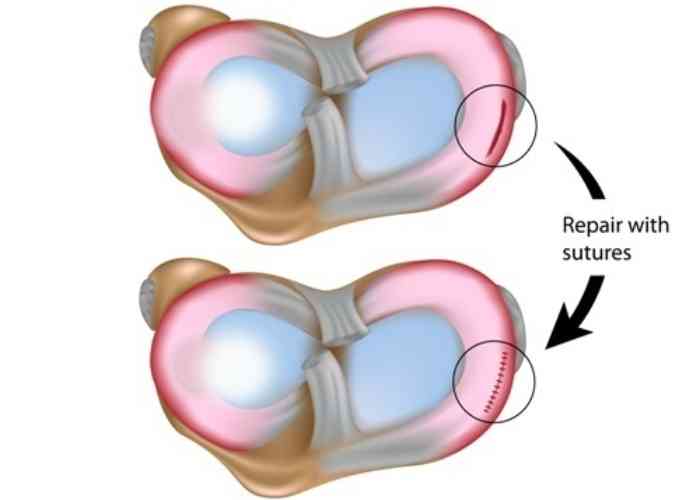What is a meniscus tear?
The meniscus is a crescent-shaped disc that is located between the ends of the femur (thigh bone) and tibia (shin bone). Each knee joint contains two of these meniscus cartilage discs: a medial meniscus and a lateral meniscus. This rubbery and tough connective tissue reduces friction by acting as a shock absorber with joint movement. When the full weight of the body is placed on the knee and a forceful rotation occurs, the result can be a tear of the meniscus cartilage. This is a common injury among athletes and especially those that participate in contact sports such as football or wrestling.
What is the treatment for a meniscus tear?
The outer third portion of the meniscus cartilage, known as the “red zone”, contains a rich blood supply that allows small tears and other injuries to heal with non-surgical therapies alone. However, the “white zone”, which encompasses the inner two-thirds of the meniscus cartilage, lacks this necessary blood supply and therefore is not capable of spontaneously healing any damage to this region. In the event of failed conservative, or non-surgical therapy, or when meniscus injuries affect this “white zone”, surgical intervention is often needed to restore the meniscus cartilage. Surgical repair of the meniscus cartilage aims to preserve the healthy meniscus tissue while also minimizing the risk of developing arthritis. When formulating an appropriate treatment plan, factors such as the patient’s age, activity level, medical history, injury severity, and location of the tear are taken into consideration. Dr. Ronak Mukesh Patel, orthopedic knee doctor, treats patients in Sugar Land, Pearland, and the Houston, Texas area, who have experienced a meniscus tear and are in need of surgical repair.

How is a meniscus repair performed?
A meniscus repair begins with an examination under anesthesia to confirm the meniscus tear diagnosis. Small incisions are then created surrounding the knee joint and a small camera (arthroscope) is inserted through one of the portals. The images from the arthroscope are transmitted to a screen for Dr. Patel to methodically examine the knee joint structures and document any other conditions that will also need to be addressed. After assessing the location, size, tear type, tissue quality, and cartilage health, Dr. Patel will decide the best surgical repair technique to implement. Specialized surgical instruments are introduced to excise and remove the damaged tissue fragments. The remaining healthy meniscus tissue is sutured back together and re-attached in the correct anatomical position with special surgical anchors that are secured within the bone.
For patients with a larger or more complex meniscus tear, Dr. Patel may combine an open surgery technique with the arthroscopic meniscus repair. The addition of two small incisions on opposite ends of the knee allows Dr. Patel to finalize the meniscus repair after the necessary arthroscopic revisions are completed.
Alternative biologic treatments may also be implemented as an enhancement measure for meniscus repair. A suspension of platelet-rich plasma (PRP), or the patient’s own Bone Marrow Aspirate Concentrate (BMAC) is injected into the knee joint at the site of repair to stimulate tissue healing at the injury site. Vascular access channels (also know as marrow venting) can also be created by Dr. Patel to promote bleeding of the joint lining.
What is the recovery period like after a meniscus repair?
The extent of the meniscus tear, as well as the specific surgical technique employed by Dr. Patel, often determines the recovery period following a meniscus repair. Although arthroscopic surgical procedures have repeatedly been found to reduce recovery time, the bones and soft-tissue structures still take the same amount of time to heal. Most patients can expect a return to normal daily activities in approximately 4 to 6 weeks and sports in 4 to 5 months depending on prior fitness level. Compliance with the post-operative instructions provided by Dr. Patel can also greatly affect the recovery process. Patients in the Houston, Texas area can generally expect the following:
- A brace will be required immediately after surgery and continue for up to 6 weeks. Crutches will be needed for 4 to 6 weeks. Weight-bearing activities start immediately. Knee range of motion is limited to 0 to 90 degrees for 4 weeks.
- A combination of rest, ice, and non-steroidal anti-inflammatory medications (NSAIDs) are encouraged to manage any post-operative pain and inflammation. If necessary, Dr. Patel may prescribe stronger pain medication to be taken as directed.
- The key to a successful recovery following a meniscus repair is active participation and completion of the physical rehabilitation program set forth by Dr. Patel. This physical therapy program typically begins with passive range of motion exercises and gradually progresses to active strengthening exercises.
Meniscus Repair Surgeon

Are you an athlete who participates in sports that involve running, jumping or quick pivoting? If so, you may be at risk of tearing your meniscus. A meniscus tear can occur due to a traumatic event or degeneration. Meniscus repair surgeon, Doctor Ronak Mukesh Patel, provides diagnosis as well as surgical and nonsurgical treatment options for patients in Houston, Sugar Land, and Pearland, TX who have torn their meniscus. Contact Dr. Patel’s team today!








